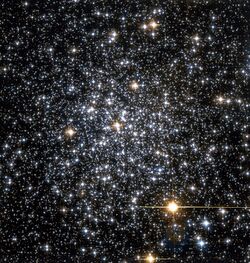NGC 6352
Topic: Astronomy
 From HandWiki - Reading time: 3 min
From HandWiki - Reading time: 3 min
| NGC 6352 | |
|---|---|
 | |
| Observation data (J2000 epoch) | |
| Class | XI:[1] |
| Constellation | Ara |
| Right ascension | 17h 25m 29.11s[2] |
| Declination | –48° 25′ 19.8″[2] |
| Distance | 18.3 kly (5.6 kpc)[3] |
| Apparent magnitude (V) | +7.8[4] |
| Apparent dimensions (V) | 7.1′[5] |
| Physical characteristics | |
| Mass | 3.7×104[6] M☉ |
| Tidal radius | 10.5″[7] |
| Metallicity | [math]\displaystyle{ \begin{smallmatrix}\left[\ce{Fe}/\ce{H}\right]\end{smallmatrix} }[/math] = –0.70[8] dex |
| Estimated age | 12.67 Gyr[8] |
| Other designations | Caldwell 81, Cr 328, NGC 6352[9] |
NGC 6352 (also known as Caldwell 81) is a globular cluster of stars in the southern constellation of Ara, located approximately 18.3 kly[3] from the Sun. It was discovered by Scottish astronomer James Dunlop on May 14, 1826.[10] The cluster has a Shapley–Sawyer Concentration Class of XI:.[1] A telescope with a 15 cm (5.9 in) aperture is required to resolve the stars within this loose cluster.[4]
This cluster is about 12.67[8] billion years old with two distinct stellar populations; the second generation is only around 10 million years younger than the first.[3] It lies approximately 13 kly (4 kpc) from the Galactic Center and 1.6 kly (0.5 kpc) from the galactic plane.[11] The orbital motion of this cluster through the Milky Way suggests it is a member of the bulge or disk population.[12] It is relatively metal-rich for an object of this class,[3] having a metallicity of –0.70.[8] The core radius is 49.8″[3] and the tidal radius is 10.5″.[7]
References
- ↑ 1.0 1.1 Shapley, Harlow; Sawyer, Helen B. (August 1927), "A Classification of Globular Clusters", Harvard College Observatory Bulletin 849 (849): 11–14, Bibcode: 1927BHarO.849...11S.
- ↑ 2.0 2.1 Goldsbury, Ryan et al. (December 2010), "The ACS Survey of Galactic Globular Clusters. X. New Determinations of Centers for 65 Clusters", The Astronomical Journal 140 (6): 1830–1837, doi:10.1088/0004-6256/140/6/1830, Bibcode: 2010AJ....140.1830G.
- ↑ 3.0 3.1 3.2 3.3 3.4 Libralato, Mattia et al. (March 2019), "The Hubble Space Telescope UV Legacy Survey of Galactic Globular Clusters. XVIII. Proper-motion Kinematics of Multiple Stellar Populations in the Core Regions of NGC 6352", The Astrophysical Journal 873 (2): 12, doi:10.3847/1538-4357/ab0551, 109, Bibcode: 2019ApJ...873..109L.
- ↑ 4.0 4.1 Dunlop, Storm (2005). Atlas of the Night Sky. HarperCollins. ISBN 978-0-00-717223-8. https://archive.org/details/collinsatlasofni0000dunl.
- ↑ O'Meara, Stephen James (2002). Deep Sky Companions: The Caldwell Objects. Cambridge University Press. p. 324. ISBN 0-521-82796-5.
- ↑ Marks, Michael; Kroupa, Pavel (August 2010), "Initial conditions for globular clusters and assembly of the old globular cluster population of the Milky Way", Monthly Notices of the Royal Astronomical Society 406 (3): 2000–2012, doi:10.1111/j.1365-2966.2010.16813.x, Bibcode: 2010MNRAS.406.2000M. Mass is from MPD on Table 1.
- ↑ 7.0 7.1 Johnston, H. M. et al. (May 1996), "ROSAT observations of ten globular clusters with large core radii.", Astronomy and Astrophysics 309: 116–122, Bibcode: 1996A&A...309..116J.
- ↑ 8.0 8.1 8.2 8.3 Forbes, Duncan A.; Bridges, Terry (May 2010), "Accreted versus in situ Milky Way globular clusters", Monthly Notices of the Royal Astronomical Society 404 (3): 1203–1214, doi:10.1111/j.1365-2966.2010.16373.x, Bibcode: 2010MNRAS.404.1203F.
- ↑ "NGC 6352". SIMBAD. Centre de données astronomiques de Strasbourg. http://simbad.u-strasbg.fr/simbad/sim-basic?Ident=NGC+6352.
- ↑ Seligman, Courtney. "New General Catalogue objects: NGC 6350 - 6399". https://cseligman.com/text/atlas/ngc63a.htm#6352.
- ↑ Fullton, L. K. et al. (August 1995), "A VIC Color-Magnitude Diagram of the Globular Cluster NGC 6352 From Hubble Space Telescope Planetary Camera Observations", Astronomical Journal 110: 652, doi:10.1086/117552, Bibcode: 1995AJ....110..652F.
- ↑ Wagner-Kaiser, R. et al. (July 2016). "Bayesian Analysis of Two Stellar Populations in Galactic Globular Clusters. II. NGC 5024, NGC 5272, and NGC 6352". The Astrophysical Journal 826 (1): 18. doi:10.3847/0004-637X/826/1/42. 42. Bibcode: 2016ApJ...826...42W.
External links
 |
 KSF
KSF